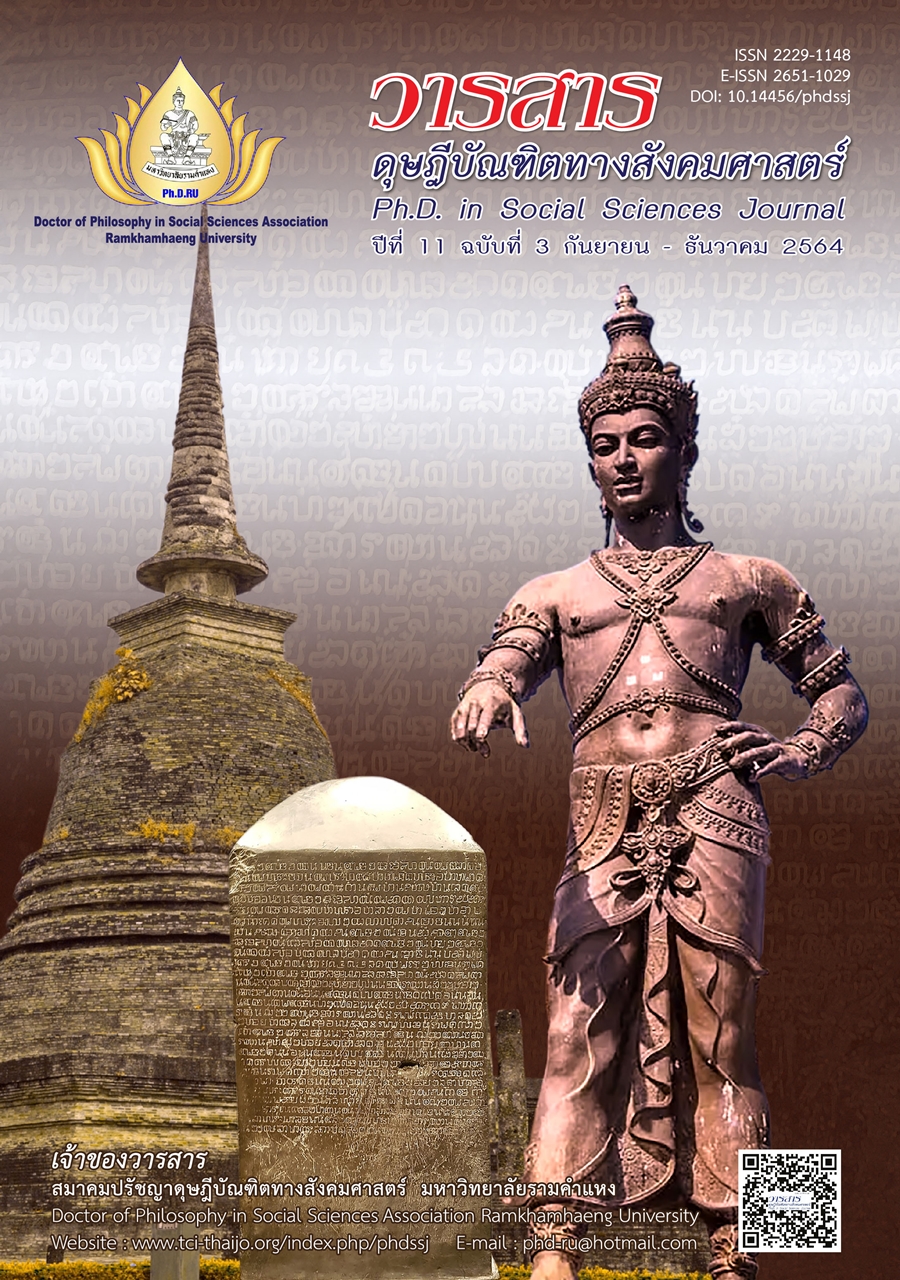The Effects of Price Value and Privacy Concern on the Behavioral Intention to Use Wristbands for Health in Controlling the Relationship with Personal Innovativeness and Coupon Proneness and the Effects of Behavioral Intention to Use and Willingness to Pay and Provide Personal Information
Main Article Content
Abstract
The objective for this study is focused on the antecedent and outcome since controlled expectancy variables are as Performance Expectancy, Effort Expectancy Functional Congruence and Hedonic Motivation, and the Relationship Between Privacy Concern and Price Value on Behavioral Intention to Use Wristband for Health Influence. By multistage sampling Example of 338 people, to Use Wristbands for Health in Bangkok and its vicinity. And qualitative research In-depth interviews with 5 experts and group interviews of 4 were conducted. and Data were analyzed by content analysis.
Findings are as follows: The moderating effects of personal innovativeness on changes in the relationships between price value and behavioral intention to use the research found that personal innovativeness influenced the relationships between price value and behavioral intention to use. Furthermore, the research investigated that, Behavioral intention to use influenced the relationship between both willingness to pay and willingness to provide personal information. All 4 situations as mentioned above are statistically significant levels even before and after controlled expectancy variables.
Article Details
Academic articles, research articles, and book reviews in the Ph.D. in Social Sciences Journal are author’s opinions, and not the publisher’s, and is not the responsibility of the Ph.D. in Social Sciences Journal Philosophy Association, Ramkhamhaeng University. (In the case that research is done on human, the researcher has to be trained in Ethics for Doing Research on Human Training and has to produce the evidence of the training).
References
Accenture. (2014). The Internet of things: The future of consumer adoption. Retrieved from https://rb.gy/xuguax
Agarwal, R., & Prasad, J. (1998). A conceptual and operational definition of personal innovativeness in the domain of information technology. Information Systems Research, 9(2), 204-215.
Buchanan, T., Paine, C., Joinson, A. N., & Reips, U. D. (2007). Development of measures of online privacy concern and protection for use on the Internet. Journal of the American Society for Information Science and Technology, 58(2), 157-165.
Chantavanich, S. (2016). Data analysis in qualitative research (12th ed.). Chulalongkorn University Press. [In Thai]
Chaveesuk, S., & Vongjaturapat, S. (2012). Theory of information technology adoption. KMITL Information Technology Journal, 1(1), 1-21. [In Thai]
Davis, F. D. (1985). A technology acceptance model for empirically testing new end-user information systems: Theory and results. Unpublished doctoral dissertation, Massachusetts Institute of Technology.
Dinev, T., & Hart, P. (2006). An extended privacy calculus model for e-commerce transactions. Information Systems Research, 17(1), 61-80.
Gall-Ely, M. L. (2009). Definition, measurement and determinants of the consumer’s willingness to pay: A critical synthesis and directions for further research. Recherché et Applications Marketing, 24(2), 91-113.
Gao, Y., Li, H., & Luo, Y. (2015). An empirical study of wearable technology acceptance in healthcare. Industrial Management & Data Systems, 115(9), 1704-1723.
Hayes, A. F. (2017). Introduction to mediation, moderation, and conditional process analysis: A regression-based approach (2nd ed.). Guilford.
Huber, F., Vollhardt, K., Matthes, I., & Vogel, J. (2010). Brand misconduct: Consequences on consumer-brand relationships. Journal of Business Research, 63(11), 1113-1120.
Jeong, N., Yoo, Y., & Heo, T. Y. (2009). Moderating effect of personal innovativeness on mobile-RFID services: Based on Warshaw’s purchase intention model. Technological Forecasting and Social Change, 76(1), 154-164.
Jianlin, W., & Qi, D. (2010). Moderating effect of personal innovativeness in the model for e-store loyalty. In 2010 International Conference on E-Business and E-Government (pp. 2065-2068). IEEE.
Kowatsch, T., & Maass, W. (2012). Critical privacy factors of internet of things services: An empirical investigation with domain experts. Paper presented at the conference on the 7th Mediterranean Conference on Information Systems, MCIS 2012. Guimaraes, Portugal.
Kumar, P. N., Ali, F., & Leong, L. C. (2015). Factor affecting acceptance & use of rewind: Validating the extended unified theory of acceptance and use of technology. Interactive Technology and Smart Education, 12(3), 183-201.
Lichtenstein, D. R., Netemeyer, R. G., & Burton, S. (1990). Distinguishing coupon proneness from value consciousness: An acquisition-transaction utility theory perspective. Journal of Marketing, 54(3), 54-67.
Moon, Y. (2016). Statistical of effect of extended UTAUT variables on user acceptance of smart wearable devices and use behavior. Journal of Computer Science and Information Engineering, 3(3), 16-22.
Nunnally, J. C. (1967). Psychometric theory. McGraw-Hill.
Piriyakul, M. (2020). Sample size determination for Structural Equation Modeling (SEM). Retrieved from http://www.research.ru.ac.th/images/ArticleMr/1544072259_Article.pdf [In Thai]
Sarkarm, S., & Khare, A. (2017). Moderating effect of price perception on factors affecting attitude towards online shopping. Journal of Marketing Analytics, 5(2), 68-80.
Singh, S. (2015). Consumer behavioural intentions toward Internet marketing. Global Journal of Science Frontier Research: Einterdiciplinary, 15(1), 1-16.
Swaminathan, S., & Bawa, K. (2005). Category-specific coupon proneness: The impact of individual characteristics and category-specific variables. Journal of Retailing, 81(3), 205-214.
Thaler, R. (1985). Mental accounting and consumer choice. Marketing Science, 4(3), 199-214.
Van der Heijden, H. (2004). User acceptance of hedonic information systems. MIS Quarterly, 28(4), 695-704.
Venkatesh, V., Morris, M. G., Davis, G. B., & Davis, F. D. (2003). User acceptance of information technology: Toward a unified view. MIS Quarterly, 27(3), 425-478.
Venkatesh, V., Thong, J. Y. L., & Xu, X. (2012). Consumer acceptance and use of information technology: Extending the unified theory of acceptance and use of technology. MIS Quarterly, 36(1), 157-178.
Weinswig, D. (2016). Wear 2016: Wearable tech, data and style. Retrieved from https://www.deborahweinswig.com/wear-2016-wearable-tech-data-and-style
Yang, L., Yang, S. H., & Plotnick, L. (2013). How the Internet of things technology enhances emergency response operations. Technological Forecasting and Social Change, 80(9), 1854-1867.
Yan, Z., Zhang, P., & Vasilakos, A. V. (2014). A survey on trust management for internet of things. Journal of Network and Computer Applications, 42, 120-134.


